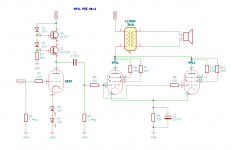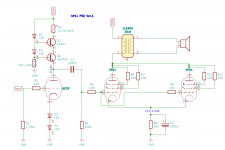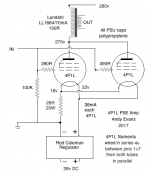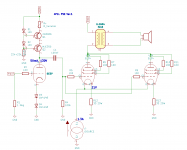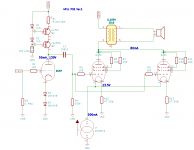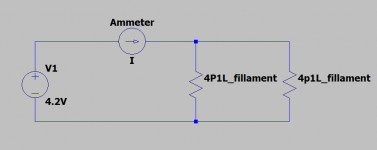I am planning to build this amplifier. I would be more than happy if someone could take a peak and give constructive advice or/and correction to this build. This is ver. 1, so in the near future I am planning to update it after I do some measurments and listening tests.
Any suggestions are welcome.
Any suggestions are welcome.
Attachments
Q1 collector to B+ needs a resistor to set current. Also that 50K LED bias resistor will need to be a 6W part, but you may not need to run so much LED bias current (depending on what your actual CCS current is).
1 meg of grid leak on the 4P1L seems a little high. You have a 6E5P on the previous stage, so even going to 100K there won't make much of a difference (resize the coupling cap accordingly).
If you have the freedom to have one filament supply per tube and one cathode resistor/bypass cap per tube, that would be adventageous.
1 meg of grid leak on the 4P1L seems a little high. You have a 6E5P on the previous stage, so even going to 100K there won't make much of a difference (resize the coupling cap accordingly).
If you have the freedom to have one filament supply per tube and one cathode resistor/bypass cap per tube, that would be adventageous.
Of course it does!Q1 collector to B+ needs a resistor to set current.
If you have the freedom to have one filament supply per tube and one cathode resistor/bypass cap per tube, that would be adventageous.
This would be kind of tricky. Dont know the solution yet.
Updated accordingly.
Attachments
Last edited:
A couple of comments:
1. In the anode-load CCS, please swap the collectors & emitters around in Q1 and Q2, in order to make a current-source (You need an emitter to fix the voltage across the current-program resistor - a collector will not do that).
2. 20mA is very low for Russian 6Э5П (6E5P), at any anode voltage. I don't think it will perform well like that.
3. The 4П1Л does not require high grid-drive voltage swing, so you could consider running the 6Э5П at Va=130V and use an anode supply voltage of 200V or even lower. Now you can increase the anode current easily. Lower supply voltage gives more choice for the CCS cascode PNP transistor, including power-FETs that can handle more power.
1. In the anode-load CCS, please swap the collectors & emitters around in Q1 and Q2, in order to make a current-source (You need an emitter to fix the voltage across the current-program resistor - a collector will not do that).
2. 20mA is very low for Russian 6Э5П (6E5P), at any anode voltage. I don't think it will perform well like that.
3. The 4П1Л does not require high grid-drive voltage swing, so you could consider running the 6Э5П at Va=130V and use an anode supply voltage of 200V or even lower. Now you can increase the anode current easily. Lower supply voltage gives more choice for the CCS cascode PNP transistor, including power-FETs that can handle more power.
Thanks for the comments!
ups. my mistake. I will correct that.
I thought this is the most linear region of 6Э5П. What current do you suggest 30-40mA?
1. In the anode-load CCS, please swap the collectors & emitters around in Q1 and Q2, in order to make a current-source (You need an emitter to fix the voltage across the current-program resistor - a collector will not do that)
ups. my mistake. I will correct that.
2. 20mA is very low for Russian 6Э5П (6E5P), at any anode voltage. I don't think it will perform well like that.
I thought this is the most linear region of 6Э5П. What current do you suggest 30-40mA?
The data-sheet op. point for 6Э5П is [tetrode] 150V 43mA, and it is much more linear there, than at lower current, tetrode or triode. Please check the curves!
I would be tempted to try triode 130V 50mA for 4П1Л driver.
In any case, you can try many more options, if the CCS can support high current.
I would be tempted to try triode 130V 50mA for 4П1Л driver.
In any case, you can try many more options, if the CCS can support high current.
Complete novice here but should R9 connect before R5, rather than after?
It should, thanks!
After few experiments and some more thinking. I reconsidered bias point for 6Э5П and also I will try to implenet fillament bias for 4П1Л as suggested.
Attachments
Last edited:
Where do you get 500mA for the 4P1L filaments? Have another look at my schematic. I connect each tube in series and then both in parallel. Voltages as shown.
40mA may be a little high in terms of current. I don't think you need to go over 35mA per tube. I don't see the HT voltages. I connected each tube in series to lower the total current to 650mA since I use choke input to Rod's Regs and that gives me more choices of chokes - Hammond 159Y in my case.
40mA may be a little high in terms of current. I don't think you need to go over 35mA per tube. I don't see the HT voltages. I connected each tube in series to lower the total current to 650mA since I use choke input to Rod's Regs and that gives me more choices of chokes - Hammond 159Y in my case.
Last edited:
Where do you get 500mA for the 4P1L
I just connected two tubes on the bench with 4.2V without any load and it draws 500mA
Doesn't make sense to me. I check my tubes' filaments with a bench supply which shows me voltage and current to see if they're good. Should be close to the data values. When you try out 2 tubes in filament bias on the bench you need to connect up the resistor to ground and check the voltage at the cathode. The filament supply goes through the resistor.
Doesn't make sense to me. I check my tubes' filaments with a bench supply which shows me voltage and current to see if they're good. Should be close to the data values. When you try out 2 tubes in filament bias on the bench you need to connect up the resistor to ground and check the voltage at the cathode. The filament supply goes through the resistor.
Will doo that. Thanks!
The connections are shown in the schematic I posted, plus the voltages you should expect. I seriously recommend Rod Coleman's regs if you want the 4P1Ls to sound as good as they can. I have several bench supplies which are 30v at 2A. Perfect for setting up this kind of thing.
- Status
- This old topic is closed. If you want to reopen this topic, contact a moderator using the "Report Post" button.
- Home
- Amplifiers
- Tubes / Valves
- Yet another 4P1L PSE amp - review request
